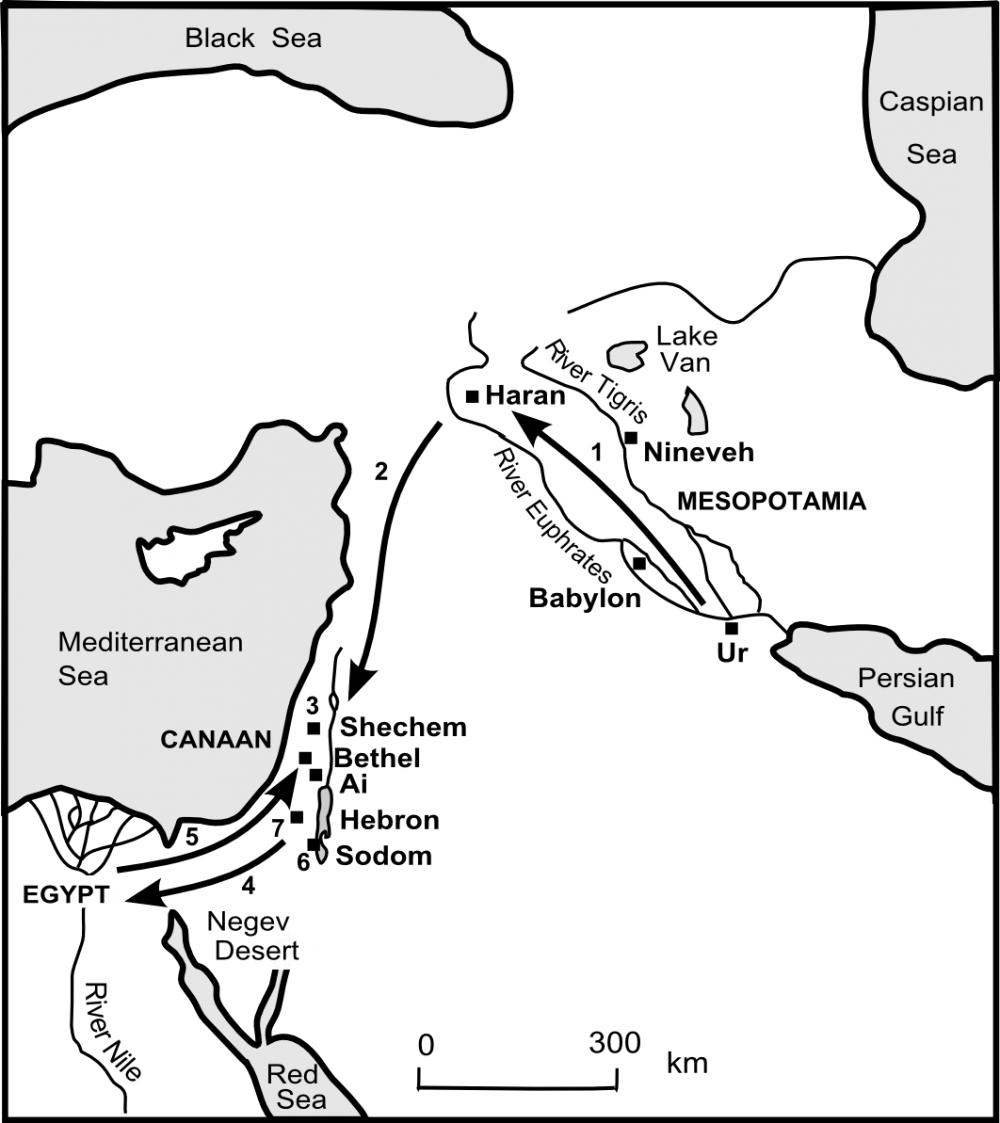Gen 11:10-26 The Book of Genesis lists many generations of Shem’s descendants including Terah and Abram (later called Abraham).
The story then recommences nearly a thousand years after the building of the Tower of Babylonia when Abram is born in the Amorite kingdom of Mesopotamia, in c.1900BC.
Gen 11:28 Terah and his family (including his sons Abram and Nahor, and his grandson Lot) live at Ur in Mesopotamia (see Map 38).

Map 38 Abram's Journey to Canaan
Ur
Ur developed during the reign of the Sumerian kings (c.3000 – 2300BC) and had been a major city for hundreds of years when Abram was born. A ‘ziggurat’ (a stepped temple platform) about 70 feet / 21 metres high, surmounted by a temple and shrine to the Akkadian moon god Sin, was built by King Ur-Nammu in c.2100BC, using a solid mud brick core covered with waterproof baked mud bricks.
Archaeologists in the 1920s discovered thousands of graves dating back to the first dynasty of the Sumerian kings, including several so-called ‘death-pits’ where royal harpists and members of the royal court had taken poison before being buried above the tomb of their dead monarch. One of these ‘Royal Tombs’, contained the queen’s exquisite jewellery as well as a harp, a lyre, gold bowls and silver jugs.
Modern-day travellers to the site of Ur in southern Mesopotamia (near Basra in modern-day southern Iraq) can visit the archaeological remains of the Royal Tombs of the Sumerian Kings (dating from c.2600BC), excavated by Leonard Woolley in the 1920s, together with the partially reconstructed remains of the Ziggurat of Ur. Many items from the tombs are on display at the British Museum in London.

Queen Pu-abi's gold pendant from the Royal Tombs of Ur
Gen 11:31-32 Terah and his family decide to move from Ur and follow the River Euphrates upstream for about 600 miles / 950km to Haran (see 1 on Map 38). Haran is the name of Abram's brother (see Genesis 11:27) so Terah apparently re-named the place Haran in memory of his son, Lot's father, who had died before the family left Ur (Genesis 11:28).
Haran
Haran is one of the oldest cities on earth that is still inhabited today. Founded by settlers migrating west from Mesopotamia in the 18th century BC, the city was at its peak during the Hittite Empire, based on Central Anatolia in the 12th century BC. It was already centuries old when the Hittites fought Ramesses II of Egypt at the Battle of Kadesh in 939 BC.
Modern travellers to Harran (Haran), 30 miles / 48km south of Sanliurfa in south eastern Turkey, can sense the antiquity of the settlement when they encounter its decaying walls, the ruins of the ancient 11th century citadel, and the remains of the Old Mosque. Haran is famous for its unique beehive-shaped mudbrick houses that originated in the 3rd century BC and which have been rebuilt in the same style many times during the intervening centuries.

Traditional bee-hive shaped houses at Harran (Glumik)
Gen 12:1-3 God calls Terah’s son Abram to “Leave your country… and go to the land I will show you.” God establishes a covenant agreement with Abram to give his family the ‘promised land’ of Canaan (later called Palestine). This solemn agreement – which is renewed on many occasions – becomes the recurring theme of the Old Testament (‘testament’ means ‘covenant’ or solemn agreement).
Gen 12:4-5 In c.1855BC, Abram and his nephew Lot set out for Canaan, about 400 miles / 640km away, with their tents and flocks (see 2 on Map 38).
